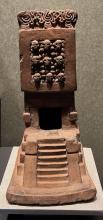teocalli (T2782:15:17r)
The iconographic element of an autonomous-era temple pyramid (teocalli) is depicted on an Indigneous-authored pictorial manuscript created around 1590. It is associated with a second element, a Spanish-style church. The pair of structures, old and the new sacred buildings, stand next to a gloss reading "otunba," together indicating the location of the cabecera (head town) of Otompan, modern day Otumba, a place at least originally associated with the Otomí ethnic group. We are supplying the term teocalli here, given that it does not appear in any glosses or texts on the manuscripts. The word used locally could have been otonteocalli, a term referring to an Otomí or Otomí-style temple. The teocalli is drawn in black. It faces to the right in profile and bears an elaborate tripartite roof or roof comb or crest which appears to be thatched. The detail of the thatch construction is especially gratifying. It has a t-shaped entryway at the top of a series of steps and rests on a raised trapezoidal base. The church is also drawn in black but is presented in a more "European" frontal view (see the historical contextualizing image). The creator of the manuscript and these images relied on the Spanish gloss rather than an obvious place glyph to identify the community specifically (see the gloss image, below).
Robert Haskett
The image of the teocalli and the pictorial upon which it is found is included in the records of an investigation of the possible alienation of land in the region administered by the Nahua town council of Otumba. The property in question was located near the dependent pueblos of Axoloapan, Calpulalpan, and Ahuatepec. These towns were potentially affected by a pending grant of a sitio de estancia de ganado menor (ranch for small livestock) and two caballerías of land requested by the Spaniard Antón de Loza Moreno.
Robert Haskett
otunba
Otompan (modern day, Otumba)
Robert Haskett
1590
Robert Haskett
temple, templo, church, iglesia, pueblo, altepetl, crestería
This mock-up of a teocalli shows a very different architectural design from the hieroglyph above, but both have superstructures. Often, in the glyphs, the teocalli is shown in profile, unlike this ceramic one from the museum. Photograph by Stephanie Wood, Museo Nacional de Antropología e Historia, February 2023.
teocal(li), a temple or church (synonymous with teopan); or, something smaller, such as a chapel, https://nahuatl.wired-humanities.org/content/teocalli
otonteocal(li), an Otomí temple, https://nahuatl.wired-humanities.org/content/otonteocalli
teo(pan), church; at the church, https://nahuatl.wired-humanities.org/content/teopan
teopancal(li), temple, church, https://nahuatl.wired-humanities.org/content/teopancalli
teopan(tli), templo o iglesia, https://nahuatl.wired-humanities.org/content/teopantli
el templo, o la iglesia
Robert Haskett
Single-page codex, Archivo General de la Nación, México, Ramo de Tierras Vol. 2782, Exp. 15, Fol. 17r.
The Archivo General de la Nación (AGN), México, holds the original manuscript. This image is published here under a Creative Commons license, asking that you cite the AGN and this Visual Lexicon of Aztec Hieroglyphs.








